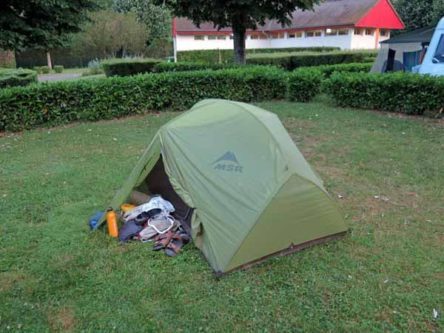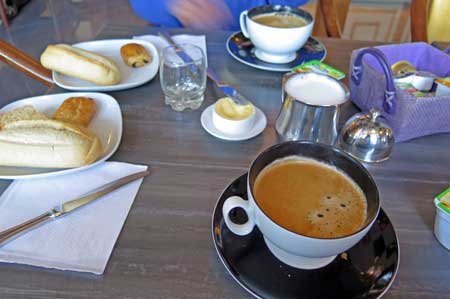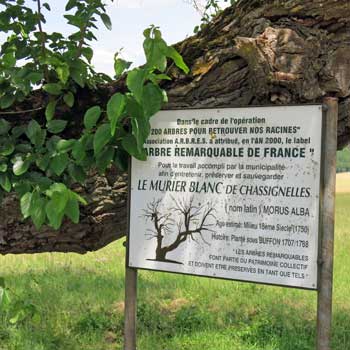
Thursday, 25 June 2015
Distance 32 km
Duration 6 hours 40 minutes
Ascent 74 m, descent 73 m
Map 129 of the TOP100 lime-green series
Our phone call last night to the hotel at Buffon had confirmed that we could have breakfast there, any time from 7:30 am, so we got up at 6 am and were on the road half an hour later. Even for me, six kilometres did not seem too far to go for a guaranteed proper breakfast.

As we left, the morning sun lit up the crenellated Tour de l’Aubespin of the old fortress on the hill, with its bright heraldic symbols.
We descended gently towards the canal on a small local road through the parkland between the ring road and the river. At the bottom the canal passed over the river on a bridge and there was a lock, at which we were able to cross onto the towpath and get back into our normal rhythm.

Although the sky was not the deeply-dyed blue of yesterday, the morning was sunny and warm.
We passed a few people riding bikes or walking their dogs, and arrived at Buffon at about 7:40.
The hotel was an old red-roofed stone house, only distinguished from its neighbours by the flags, awnings and grand covered entranceway in front.

There was a terrace, but it was in the shade and breakfast was being served indoors.
Our host, who was polite but uncommunicative, produced huge bowls of coffee from a machine and brought a basket of fresh bread, pastries, butter and jam. Some other early risers were hard at work on their breakfasts, but probably did not appreciate them as much as we did.

Setting off again, we quickly came to the beautiful old forge of Buffon, built in the eighteenth century by one of the counts of Buffon (the same one who had bought the dilapidated fortress in Montbard and developed the Parc Buffon around it).
This count was an amateur scientist, and the forge used water from the Armançon to power the bellows, hammers and other machinery for his investigations.

A few kilometres further on we came to another forge, at Aisy, where this same eccentric count had conducted his first experiments before building his premises at Buffon. This one looked more traditional with its tall chimney and sawtooth factory roof.
We walked on for another uneventful hour (during which I had an exciting time with the future emperor Augustus, chasing Antony and Cleopatra around the Mediterranean), and arrived at a road going off to the village of Cry, a couple of hundred metres away on the banks of the river Armançon.

As we had hoped, there was a bar in the square and we joined a group of locals in the comfortable front room, with its clutter of posters and old photographs, for a second round of coffee.
Beyond Cry the canal looped around under a line of cliffs, where a former quarry had left great square blocks of exposed limestone. In this inhospitable environment, according to a sign, lived a species of violet unique in the world.

Another loop, lined with poplars, brought us to a long straight stretch. The locks were much farther apart now that we were away from the watershed.

We soon reached the town of Ravières, where blocks of limestone were stacked on a wharf beside the canal, the last remnant of the stone-cutting industry that had dominated this area in the nineteenth century.
It was midday and getting hot, so we did not go up to the centre of the village, but stopped at a bar beside the canal and had deliciously cold Orangina on the terrace.
The next part of the canal was circuitous, and after two or three kilometres we took a short-cut on a little road over the rise, climbing up the steep escarpment onto a plateau planted with wheat, very open and breezy after the shelter of the towpath.


As we gradually descended, we saw the austere fortified church and farm which were the original centre of the village of Chasignelles, but which now stand alone – the village has migrated down to the canal.

We skirted Chasignelles on a gravel road that took us down past an ancient mulberry tree, classified as a Remarkable Tree of France, which was fully grown long before the Revolution.

Once on the canal bank, we walked along a small road (the towpath was on the other side) and then took a wide, grassy lane directly towards the camping ground, which was marked on our map at the edge of the village of Ancy-le-Franc.
The only trouble was that when we arrived, there was nothing to see but a broken boom gate, a tract of weeds, some piles of wood and a decrepit building, presumably the former shower block.
A nearby town map showed the camping ground slightly further down the D905, so we walked all the way down to the canal port, but saw no such thing.

Near the bridge there was a sign for a Logis hotel pointing back towards Chasignelles, but we have a constitutional aversion to going back on our tracks, so that did not appeal.
However, there was also a sign for a hotel in Ancy-le-Franc (l’Hostellerie du Centre), so we walked back, entered the town and immediately saw the hotel next to a small park, with its red awnings, tall shuttered facade and mansard roof, a cheering sight until we got to the door and read the notice – it was closed for holidays until the 30th of June.
Things were starting to get difficult. Apart from the matter of accommodation, there did not seem to be anywhere to eat this evening, except the bar in the side street, which only served omelettes and croques monsieur, and closed at 7 pm.

As a precaution we went to the boulangerie and bought two cold quiches and half a baguette. Then we noticed an Office of Tourism across the road and went in without much hope. The girl at the desk suggested the hotel at Chasignelles, which we were not keen on, and then she advised us to go back to the canal and ask at the Bar Associatif Éphémère.
We had seen a placard for it at the port during our fruitless search for the camping ground, but had no idea what it meant (and we are still not sure).

Once again we plodded down the highway and this time we crossed the bridge. Between the canal and the river was a grand old mill, and the cryptic sign pointed towards a low building in front of it.
We went in, to a long room full of armchairs and tables, some of them occupied, with a bar at one end. It did not look the sort of place that would offer meals or accommodation, but we asked anyway, and to our surprise the barwoman readily agreed to provide both.
She took us around behind the big mill building, to a velvety lawn beside the millstream, on which two silvery, spaceship-like American caravans rested. They were empty and, unsurprisingly, there were no other campers. The ablutions block was underneath the main mill building and looked brand new.

Incredulous at having found this lovely place, which seemed to be a close-kept local secret, we collapsed on our mats to enjoy the relief.
Then we celebrated by despatching the surprisingly delicious cold quiches. Only after that did we have showers, change our clothes and settle down for a sleep.

At about 6:30 we wandered back to the terrace of the bar for glasses of rosé in the company of a toothless old couple, and while we were sipping them we were joined by several carloads of young families, evidently from the village as they all knew one another. This made for a convivial atmosphere.
Having politely asked us whether we were ready to eat, our host pulled out the barbecue and cooked steaks for us.

I asked for one “saignant” and the other “à point”, which caused him to display his command of English by translating these as “bloody” and “well done”.
I kindly told him that “medium” would be a better word for the latter, letting pass the off-putting connotations of the former.
As dusk fell we noticed a few people going up the stairs into the mill building and we later discovered that it was a gîte. How anyone found out about it, or about the camping, or the meals, was a mystery.
Previous day: Venarey-les-Laumes to Montbard